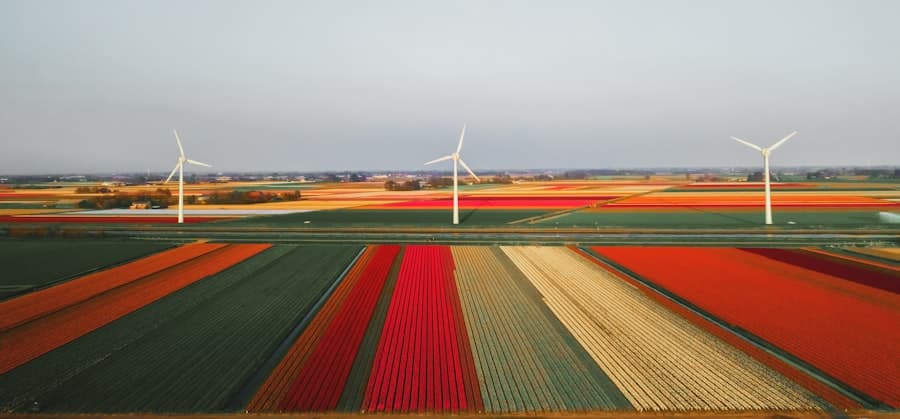The intersection of artificial intelligence (AI) and renewable energy management represents a transformative shift in how energy systems are designed, operated, and optimized. As the world grapples with the pressing challenges of climate change and the need for sustainable energy solutions, the integration of AI technologies into renewable energy systems offers unprecedented opportunities for efficiency and innovation. AI encompasses a range of technologies, including machine learning, data analytics, and neural networks, which can process vast amounts of data to derive insights and automate decision-making processes.
This capability is particularly valuable in the renewable energy sector, where variability and unpredictability are inherent characteristics of sources like solar and wind. The urgency for a transition to renewable energy sources is underscored by global commitments to reduce greenhouse gas emissions and the increasing demand for clean energy. As countries strive to meet their climate goals, the deployment of AI in renewable energy management can enhance operational efficiency, improve forecasting accuracy, and facilitate better integration of renewable sources into existing energy grids.
By leveraging AI, stakeholders in the energy sector can optimize resource allocation, reduce costs, and ultimately contribute to a more sustainable energy future.
Key Takeaways
- AI has the potential to optimize renewable energy systems by improving efficiency and reducing costs.
- AI applications in renewable energy forecasting and predictive maintenance can help in better resource management and reducing downtime.
- AI plays a crucial role in enhancing renewable energy integration and grid stability by providing real-time monitoring and control.
- AI-driven energy management systems for renewable power plants can help in maximizing energy production and minimizing waste.
- AI contributes to cost reduction and efficiency improvement in renewable energy through advanced analytics and automation.
The Potential of AI in Optimizing Renewable Energy Systems
AI has the potential to revolutionize the optimization of renewable energy systems by enabling real-time data analysis and decision-making. For instance, machine learning algorithms can analyze historical weather patterns, energy consumption trends, and equipment performance data to predict future energy generation and demand. This predictive capability allows operators to make informed decisions about when to store energy, when to sell it back to the grid, or when to draw from alternative sources.
By optimizing these processes, AI can significantly enhance the efficiency of renewable energy systems. Moreover, AI can facilitate the design of more efficient renewable energy systems from the outset. For example, during the planning phase of a solar farm, AI tools can analyze geographical data to identify optimal locations for solar panels based on sunlight exposure, land use patterns, and proximity to existing infrastructure.
This level of optimization not only maximizes energy output but also minimizes costs associated with installation and maintenance. As a result, AI-driven design methodologies can lead to more sustainable and economically viable renewable energy projects.
AI Applications in Renewable Energy Forecasting and Predictive Maintenance

Accurate forecasting is critical in the renewable energy sector due to the inherent variability of resources like wind and solar power. AI applications in forecasting utilize advanced algorithms that can process large datasets from various sources, including satellite imagery, weather models, and historical generation data. For instance, deep learning models can be trained to predict solar irradiance levels based on cloud cover patterns and atmospheric conditions.
These predictions enable energy producers to better align their generation capabilities with expected demand, thereby reducing reliance on fossil fuel backup systems. In addition to forecasting, AI plays a crucial role in predictive maintenance for renewable energy assets. Wind turbines and solar panels require regular maintenance to ensure optimal performance and longevity.
Traditional maintenance schedules often rely on fixed intervals or reactive approaches that address issues only after they arise. However, AI-driven predictive maintenance leverages real-time data from sensors embedded in equipment to monitor performance continuously. By analyzing this data, AI can identify potential failures before they occur, allowing operators to perform maintenance proactively.
This not only reduces downtime but also extends the lifespan of renewable energy assets.
The Role of AI in Enhancing Renewable Energy Integration and Grid Stability
As renewable energy sources become more prevalent in the global energy mix, integrating them into existing power grids poses significant challenges. The intermittent nature of wind and solar generation can lead to fluctuations in supply that may destabilize grid operations. AI technologies can enhance grid stability by providing real-time analytics that help grid operators manage these fluctuations effectively.
For example, AI algorithms can analyze demand response data and adjust generation schedules accordingly, ensuring that supply meets demand even during peak usage times. Furthermore, AI can facilitate the integration of distributed energy resources (DERs), such as residential solar panels and battery storage systems. By employing advanced algorithms that optimize the dispatch of these resources based on real-time conditions, grid operators can enhance overall system reliability.
AI-Driven Energy Management Systems for Renewable Power Plants
Energy management systems (EMS) powered by AI are becoming increasingly essential for optimizing the operation of renewable power plants. These systems integrate various data inputs—such as weather forecasts, market prices, and equipment performance metrics—to make real-time decisions that maximize efficiency and profitability. For example, an AI-driven EMS can determine the optimal times for energy production based on market conditions and forecasted demand, allowing operators to sell electricity at peak prices while minimizing production during low-demand periods.
Additionally, these systems can enhance operational efficiency by automating routine tasks such as scheduling maintenance or adjusting output levels based on real-time conditions. By reducing the need for manual intervention, AI-driven EMS can free up human resources for more strategic decision-making roles while ensuring that operations run smoothly. The result is a more agile and responsive renewable power plant capable of adapting quickly to changing market dynamics.
AI’s Contribution to Cost Reduction and Efficiency Improvement in Renewable Energy

Identifying Inefficiencies in Energy Production
Predictive analytics can help identify inefficiencies in energy production processes or equipment performance that may lead to increased operational costs. By addressing these inefficiencies proactively through targeted interventions informed by AI insights, operators can achieve substantial cost savings.
Optimizing Supply Chain Logistics
AI can optimize supply chain logistics for renewable energy projects by analyzing data related to material availability, transportation routes, and labor requirements. This optimization reduces delays and minimizes costs associated with project execution.
Improved Efficiency and Attractiveness
In addition to direct cost savings, improved efficiency translates into higher energy output per unit of investment, making renewable projects more attractive to investors and stakeholders alike.
Challenges and Limitations of AI in Renewable Energy Management
Despite its numerous advantages, the integration of AI into renewable energy management is not without challenges. One significant limitation is the quality and availability of data required for effective machine learning algorithms. In many cases, historical data may be sparse or inconsistent due to varying reporting standards across different regions or technologies.
This lack of reliable data can hinder the development of accurate predictive models and limit the effectiveness of AI applications. Another challenge lies in the complexity of integrating AI systems with existing infrastructure. Many renewable energy facilities operate on legacy systems that may not be compatible with modern AI technologies.
Upgrading these systems requires significant investment and expertise, which may not be readily available in all markets. Additionally, there are concerns regarding cybersecurity as increased reliance on digital technologies exposes renewable energy systems to potential cyber threats that could disrupt operations or compromise sensitive data.
Future Outlook: The Continued Evolution of AI in Renewable Energy Industry
Looking ahead, the future of AI in the renewable energy industry appears promising as technological advancements continue to evolve rapidly. The ongoing development of more sophisticated machine learning algorithms will enhance predictive capabilities further, enabling even greater accuracy in forecasting generation and demand patterns. As these technologies mature, they will likely become more accessible to a broader range of stakeholders within the industry.
Moreover, as regulatory frameworks evolve to support greater integration of renewables into national grids, there will be increased opportunities for AI applications that facilitate this transition. Innovations such as blockchain technology may also play a role in enhancing transparency and security within AI-driven energy management systems. Ultimately, as both AI technologies and renewable energy systems continue to advance hand-in-hand, they will pave the way for a more sustainable and resilient global energy landscape.
In a related article, The Best Free Software for 3D Modeling in 2023, the focus shifts to the importance of utilizing advanced software tools in the field of design and modeling. Just as AI plays a crucial role in improving renewable energy management, the use of cutting-edge software for 3D modeling can greatly enhance the efficiency and accuracy of various projects in the renewable energy sector. By leveraging these innovative tools, professionals can streamline their processes and achieve more sustainable outcomes in their work.
FAQs
What is the role of AI in renewable energy management?
AI plays a crucial role in renewable energy management by optimizing energy production, predicting energy demand, and improving overall efficiency of renewable energy systems.
How does AI optimize energy production in renewable energy systems?
AI can analyze data from renewable energy sources such as solar panels and wind turbines to optimize their performance, maximize energy production, and reduce downtime.
How does AI predict energy demand in renewable energy systems?
AI can analyze historical energy consumption data, weather patterns, and other relevant factors to accurately predict future energy demand, allowing for better planning and management of renewable energy resources.
What are the benefits of using AI in renewable energy management?
The use of AI in renewable energy management can lead to increased energy production, reduced operational costs, improved grid stability, and a more sustainable and reliable energy supply.
What are some examples of AI applications in renewable energy management?
AI applications in renewable energy management include predictive maintenance of renewable energy infrastructure, energy forecasting, grid optimization, and real-time monitoring and control of energy systems.

